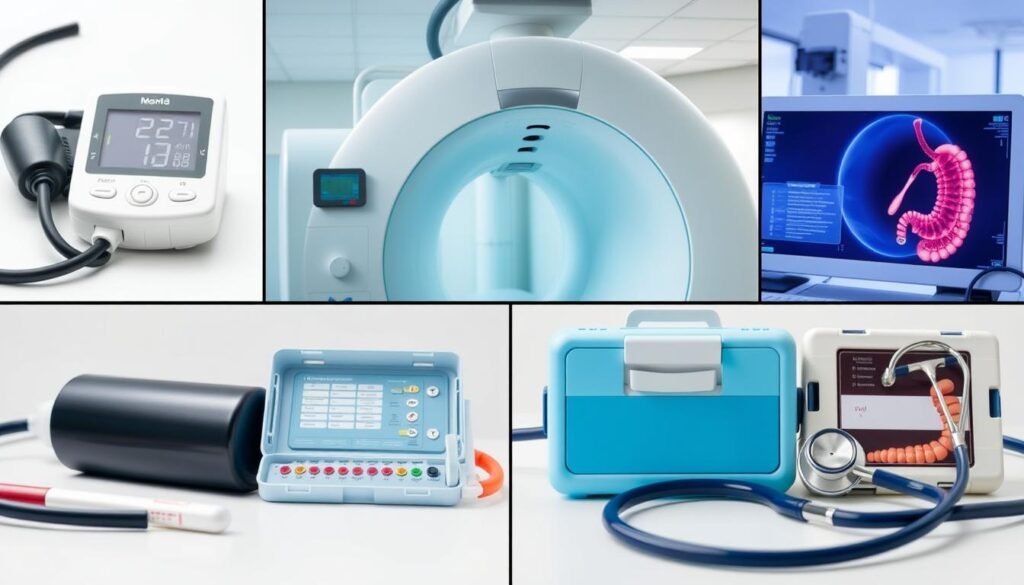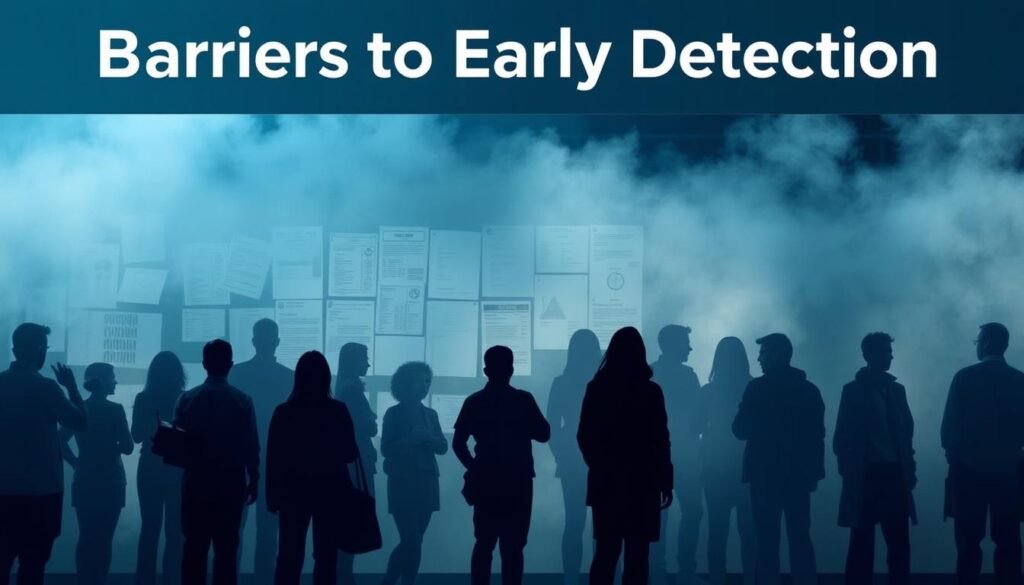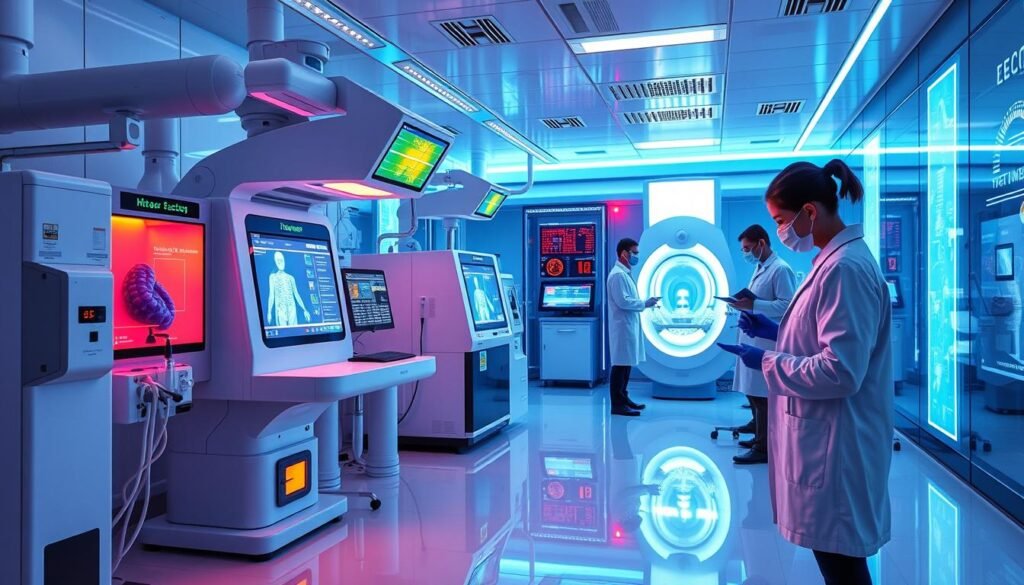Did you know that finding cervical cancer early can cut death rates by up to 80%? This amazing fact shows how important it is to check our health before issues start. In this guide, we will talk about how early detection can help. It’s key for finding problems early and starting treatment right away.
It’s crucial to understand how early detection can save lives. It lets people take control of their own health. They can start doing things that might stop diseases. Regular checks can catch problems early. This can lead to better treatment and even save lives.
Key Takeaways
- Early detection experiences significantly enhance health outcomes.
- Regular healthcare screenings are crucial for timely diagnosis.
- Screening recommendations vary by age and risk factors.
- Effective prevention strategies can markedly reduce cancer risk.
- Proactive health monitoring is essential for managing health.
Understanding the Importance of Early Detection
The importance of early detection is huge in healthcare. Getting checked regularly helps catch diseases like cancer early on. Spotting health issues early means treatments work better and are simpler.
Staying ahead of diseases prevents them from getting worse. Catching problems early leads to early treatment. This can save lives and lessen the effects of illnesses. Health experts push for regular screenings to keep you healthy. For more on the importance of cancer screening, check out this resource.
What Are Early Detection Experiences?
Early detection experiences are ways to find health problems before symptoms start. These methods help doctors catch illnesses early, which can make treatment more effective. Early detection is key to stopping diseases before they get worse. It combines many health care efforts focused on preventing illness.
Research shows early screenings work well. For example, breast cancer checks in the European Union in 2016 helped find cancer sooner. At the same time, tests for colorectal cancer reduced the number of severe cases. These screenings show how important it is for health care to focus on early tests and finding problems before they grow.
In 2017, testing for HPV DNA to screen for cervical cancer was a big step forward. Since the 1960s, such screenings have made cervical cancer much less common in places like Denmark and the U.S. This shows how crucial early detection is in fighting common diseases.
Even with its benefits, there are still hurdles to making these screenings common for everyone. Things like cost and how complex the programs are can make it hard to offer them to all who need them. But, by knowing about these challenges and investing more, we can manage diseases better. This can greatly improve health for lots of people.
| Type of Cancer | Screening Method | Impact of Screening |
|---|---|---|
| Breast Cancer | Mammography | Increased early-stage diagnosis |
| Colorectal Cancer | Colonoscopies | Reduction in advanced cases |
| Cervical Cancer | HPV DNA Testing | Significant decrease in incidence |
| Oral Cavity Cancer | Visual exams | Early identification of pre-malignant conditions |
Benefits of Timely Diagnosis
Getting diagnosed early is key in healthcare and really helps patients. Finding and acting on symptoms quickly is crucial. This leads to better control of health issues and more effective treatments.
Improved Treatment Outcomes
Early diagnosis means treatments can start when they’re most likely to work. This is especially true for chronic illnesses like diabetes and cancer. For example, catching breast cancer at stage 1 can lead to a 97.9% survival rate.
Increased Survival Rates
Spotting diseases early can save lives. For lung cancer, early diagnosis can mean a 25% lower chance of dying from the disease. Getting screened often, based on your health risks, helps find diseases soon. This leads to better health results and saves money on care.
To take command of your health, pay attention to symptoms of long-term illnesses. Knowing when to get help is key. You can find more info on staying ahead of health issues here.
Common Healthcare Screenings
Routine health checks are key to catching problems early. Learning about screenings helps people look after their health. Finding diseases early means better treatment and outcomes.
Cancer Screenings Overview
Cancer tests are crucial for catching the disease early and depend on your age and risk. Here are some common ones:
- Colonoscopy for colorectal cancer, particularly for individuals aged 45 and older.
- Mammograms for breast cancer, starting at age 40 for women with average risk.
- Lung scans for smokers aged 55 to 77 to screen for lung cancer.
- Pelvic exams with Pap smears for cervical cancer beginning at age 21.
- Prostate cancer screenings for men aged 50 to 69.
- Annual skin cancer screenings recommended for all adults.
Other Preventative Health Measures
There are more ways to stay healthy than just cancer tests. People should also get these checks:
| Screening Type | Purpose | Recommended Age |
|---|---|---|
| Cholesterol Screening | Checks levels linked to heart disease | Starting at age 20, then every 4-6 years |
| Diabetes Screening | Early detection of Type 2 diabetes | Age 45 and older |
| Bone Density Testing | Screening for osteoporosis | Starting at age 65 |
| Eye Exams | Detects cataracts and glaucoma | Every 1-2 years starting at age 60 |
| Hepatitis Screening | Recommended for everyone aged 18 and older | Any age |
Advocate Health Care suggests getting screened based on personal factors like age and history. Being proactive leads to better health and less disease risk.

Types of Disease Detection Methods
Early detection of illnesses is key. It uses tests and screenings to find health issues early. This can stop problems from getting worse. Knowing about these methods helps with preventing diseases.
Diagnostic Testing Importance
Diagnostic tests are vital in spotting health dangers. For example, cholesterol tests show who might get heart disease. The PSA test might indicate prostate cancer; however, high levels can also mean non-cancerous conditions. Other key tests include:
- Fecal occult blood test to screen for colorectal cancer starting at age 50.
- Pap smears for early detection of cervical cancer in women under 65.
- Mammography every 1-2 years for women over 50 to detect breast cancer.
- Diabetes screening recommended at age 45 for risk assessment.
- Colonoscopy for colon cancer screening advised at age 50.
Screening Techniques Explained
Screening is a cornerstone of prevention. It helps find diseases early on. However, some methods, like conventional sputum microscopy for tuberculosis, are not very accurate. This leads to diagnosis delays, especially in poor countries with few diagnostic options. For diseases like tuberculosis and malaria, we need better, quicker tests.
To sum up, knowing about testing and screening methods can greatly improve health. There’s a big need for new diagnostic tools, especially where health problems are most severe.
Medical Screening Advantages
Understanding the benefits of medical screening shows why preventative care is key. Screenings are crucial in catching diseases early. This early detection can improve treatment results and save lives. Screenings also benefit public health by lowering costs of late-stage treatments.
Cost-Effectiveness of Preventative Screenings
Screenings are cost-effective. They save money by avoiding the expenses of emergency treatments and hospital stays. Early detection through screenings means healthcare systems can use their funds more wisely. This leads to better treatments that help more people.
For instance, catching conditions like cervical and breast cancer early through screenings not only leads to better health outcomes. It also lowers costs for both patients and healthcare systems over time.
Reduced Healthcare Burden
Reducing healthcare burden starts with the benefits of screenings. They help catch diseases early, easing the load on healthcare facilities. This means less need for intense treatments of advanced diseases. Patients often enjoy better health outcomes, making healthcare more efficient.
This approach improves how resources are managed. It shifts the focus to preventative care and health education. As a result, we see a boost in the overall health of our communities. This creates a healthier environment for everyone.
| Screening Type | Cost Savings | Effect on Treatment |
|---|---|---|
| Cervical Cancer (Pap Smear) | Reduces surgery costs by early detection | Higher survival rates with early treatment |
| Breast Cancer (Mammography) | Decreases chemotherapy costs | More successful outcomes in early stages |
| Prostate Cancer (PSA Test) | Saves on advanced-stage treatment expenses | Improved prognosis with timely intervention |
Exploring Proactive Health Monitoring
Proactive health monitoring is crucial today. It lets people manage their health by checking key health indicators at home. This could be through home test kits or glucose monitors. It helps spot health problems early, leading to better health outcomes.
Continuous health assessment is becoming popular for its importance in spotting risks early. Keeping an eye on health markers is key, especially for those with chronic illnesses or the elderly. Recognizing serious symptoms quickly, like high fever or chest pain, is vital. It helps avoid worse health issues.
Using proactive steps in healthcare and other fields boosts safety and efficiency. In IT, for example, proactive monitoring cuts down system outages. This keeps services running smoothly, which is key for tech in healthcare. Tools like predictive analytics foresee potential problems, helping provide better care.
Seeking timely medical help improves health outcomes significantly. The Joint Activity Monitoring method allows real-time surveillance. This not only gives valuable insights but also supports needed actions.
Despite challenges like data privacy and false alarms, the advantages of proactive health monitoring are huge. The aim is to create a culture where everyone keeps a close watch on their health. This encourages seeking medical help when it’s needed.
| Benefit | Impact |
|---|---|
| Early detection of health issues | Improved treatment outcomes |
| Continuous health assessments | Better management of chronic conditions |
| Active engagement in personal health | Higher overall health satisfaction |
| Use of advanced monitoring tools | Enhanced efficiency of healthcare services |
Preparing for Your Screening
Getting ready for screening helps improve the experience and the results. It’s key to know what happens before, during, and after. Screenings like mammograms only take about 15 to 20 minutes. Though compression might be uncomfortable, it’s very brief.
When you schedule matters for comfort. For mammograms, try not to plan during the week before your period. Breasts can be tender then. Scheduling after your period minimizes discomfort. And wear a two-piece outfit for ease. Most places give results quickly, but some might take a few days.
Talking with the technician is vital if you’re worried or uncomfortable. Remember, most extra tests after a mammogram are standard. They don’t always mean there’s a problem.
Different colorectal screenings need different prep. For a colonoscopy, you’ll need a special diet and to clean out your bowels the day before. A flexible sigmoidoscopy has easier prep. Staying hydrated and following instructions is key. Home tests like the FIT or stool DNA test are easier. You don’t need to go anywhere.
Staying positive and planning time to rest helps with screenings. Always ask about how to prepare and what to expect. Understanding these steps can ease worry and make the experience better.
Your Role in Early Detection Experiences
People play a key role in spotting health issues early. They must actively talk to their doctors about their health. Sharing your health history and family’s medical past helps you make smart choices. It’s about being ready to take charge of your health.
Communicating with Healthcare Providers
It’s very important to talk well with your doctor. Feel free to ask questions and get details about tests and check-ups. This kind of talk helps doctors offer advice that fits you best.
Staying Informed About Risk Factors
Knowing your risk factors means you can act to prevent problems. If your family has certain health issues, or your lifestyle might cause concerns, get checked early. The American Academy of Pediatrics offers guides to track how kids grow and stay healthy. Talking about how to spot issues early can help families know when to seek help. You can learn more about this by reading about early detection strategies.
Barriers to Early Detection
Finding and tackling barriers to early detection is key to better health, especially in fighting cancer. Many hurdles stop people from getting screenings in time. This greatly impacts their chances of survival and recovery.
Lack of Access to Healthcare Screenings
Having access to healthcare deeply influences early detection. Many face obstacles that keep them from getting needed screenings. The costs, distance to facilities, and not enough services add to the problem.
A lot of folks don’t have easy access to full care, which leads to late diagnoses. Research points out that around 152,810 new colorectal cancer cases are expected in 2024. Making screenings affordable and available can cut down these barriers. This improvement can greatly boost early detection and save lives.
Misunderstanding of Screening Benefits
Wrong ideas about screening stop many from seeking early health checks. Some underplay the need and benefit of regular screenings due to fear or false information about the tests. Education that highlights the benefits can fill this knowledge gap.
For example, early-stage colorectal cancer patients have a 91% chance of surviving five years. But it drops to only 14% for late-stage diagnoses. Sharing these facts can clear up misconceptions and stress the importance of timely health care. More details are available at the American Association for Cancer Research.

Overcoming Challenges to Timely Diagnosis
Getting a diagnosis quickly is key for the best treatment and health results. This often needs joint efforts from different groups. Community health programs play a big role here. They help remove obstacles people face in getting early checks and diagnoses. By making healthcare easy to get, they boost health for everyone.
Community Health Initiatives
Community health programs use many ways to make healthcare easier to reach. They create opportunities for people to join in free screening events and learn about health without worrying about costs. This approach helps inform the public about the value of finding health issues early. For example, reaching out specially has really helped more people get screened for things like breast cancer and heart issues. This has greatly lowered the number of late diagnoses.
Improving Public Awareness
Campaigns to raise public awareness play a big role in health matters. Pointing out the good things about getting diagnosed early and the bad things about waiting too long can make people take their health seriously. Programs that stress the benefits of early screening get more people involved. As trustworthy information spreads, people start to feel less embarrassed about getting tested. This change helps everyone move towards taking care of their health sooner. Having both community programs and ongoing awareness efforts is key to solving early diagnosis problems.
Health Advances in Disease Detection
Medical science is making huge leaps in finding diseases early. New tech helps doctors spot diseases better and faster. Knowing how to catch illnesses early is key. It leads to better care and more awareness of risks.
Innovative Technologies
The way doctors test for diseases is changing. The pandemic sped up the creation of easy and quick tests. For example, Abbott’s ID NOW lets people test themselves at home. This keeps everyone safer by lowering the chance of spreading germs.
Research in Early Detection Methods
Studying how to catch diseases early is leading to big discoveries. The CDC has started programs worldwide to track diseases like the flu. This helps doctors care for us better and lets us play a part in staying healthy.
| Technology/Innovation | Description | Impact on Early Detection |
|---|---|---|
| Decentralized Testing | At-home sample collection kits and rapid tests. | Increases access and reduces delays in diagnosis. |
| AI-Driven Diagnostics | uses algorithms to analyze data for disease markers. | Enhances detection accuracy through advanced analysis. |
| Telehealth Services | Remote healthcare consultations enabling patient assessments. | Facilitates testing and follow-up without physical visits. |

Conclusion
The journey to better health starts with early detection. Taking steps early on can lead to catching diseases sooner. For example, cancer deaths in the U.S. dropped by 25% from 1990 to 2015. This happened because more people got screened early.
Education and awareness play a key role in this. They help prevent serious conditions like cancer. Deaths from colorectal and breast cancer have gone down because of good screening. As tech and research grow, we must update our methods to keep up.
Getting everyone access to screenings is vital in fighting diseases. By focusing on early detection, we can look forward to healthier futures. We must keep working on making healthcare better and more accessible for all.